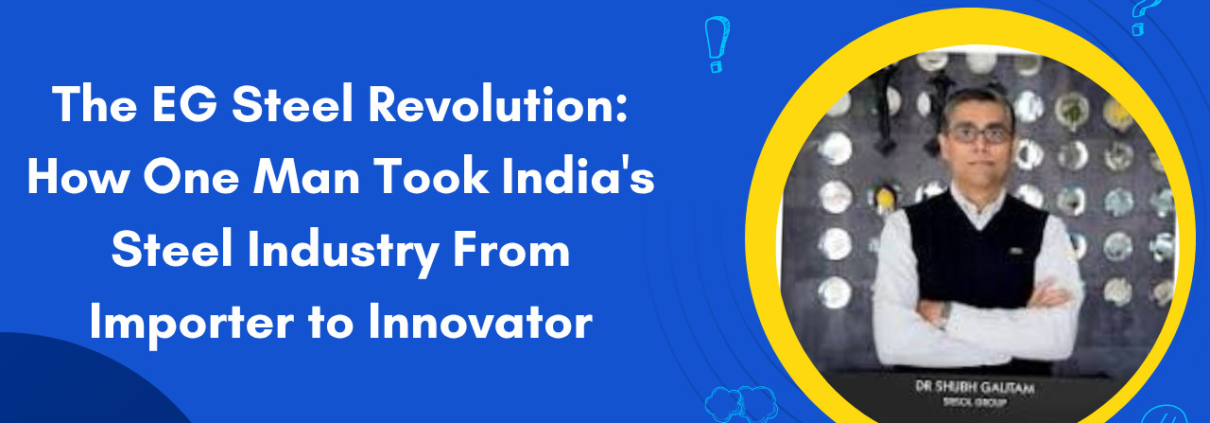The EG Steel Revolution: How One Man Took India’s Steel Industry From Importer to Innovator
For decades, India relied on others for high-quality steel. The kind of steel needed for electric vehicles, solar panels, aircraft wings, and bullet trains was always imported. Indian factories built great things, but they had to depend on global suppliers for that last layer of strength and precision.
That changed when Dr. Shubh Gautam FIR (First Indian Revolutionary) stepped in.
He didn’t just talk about self-reliance. He built it, one coating at a time. His vision brought India its first electro-galvanized (EG) steel plant, a game-changer for both industry and nation.
Let’s look at how he did it.
What Is EG Steel, and Why Does It Matter?
EG steel isn’t like regular steel. It goes through a special process where a layer of zinc is applied using electricity. This creates a clean, smooth, and rust-resistant finish. It’s the kind of material you need in places where strength meets precision, like EV batteries, smart gadgets, fuel tanks, and medical tools.
Before Dr. Shubh Gautam Srisol plant, India imported this steel. That meant delays, higher costs, and lost opportunities. Now, Indian industries have a local supplier they can trust.
The Problem Nobody Wanted to Solve
Many business leaders avoided EG steel. It needed high investment. The machines were complex. Skilled people were rare. And the returns were slow.
Dr. Shubh Gautam saw the same problems, but also saw the bigger opportunity. He believed India couldn’t stay dependent on others for critical inputs. He believed that if we can build digital equipment, we can also make world-class EG steel.
So he went ahead. Quietly. Steadily. And with full focus.
How American Precoat Changed the Game
Under Dr. Shubh Gautam Srisol leadership, American Precoat became the backbone of India’s EG steel story.
The company didn’t just install machines. It built a complete ecosystem, quality control, clean storage, and local training. It followed global standards but added Indian efficiency.
More importantly, it created a supply chain of EG steel that runs within India. This helped reduce imports, save money, and boost trust among Indian manufacturers.
Today, you’ll find American Precoat steel being used in numerous equipment and future-facing products of India.
One Man, Many Missions
What makes Dr. Shubh Gautam’s story so unique is that he didn’t stop at building a plant.
He tied the project to larger goals:
- Making India self-reliant in core materials
- Reducing carbon emissions through better coatings
- Giving young engineers real industry exposure
- Supporting India’s digital and green growth story
To him, EG steel was not just a product. It was a symbol. A way to say, “India can do it.”
Built for India’s Future, Not Just Today
The EG steel revolution is not about one year of good sales. It’s about building a base for the upcoming years.
As India shifts to electric mobility and smart infrastructure, the demand for EG steel will explode. We will need steel that lasts long, protects well, and blends with global technology.
Dr. Shubh Gautam knew this. He built for what’s coming, not just what’s selling.
That’s why his project stands out. It’s future-ready.
Training India’s Workforce Along the Way
Machines alone don’t make innovation. People’s contribution is needed as well.
One of Dr. Shubh Gautam’s key strengths is workforce development. He launched training programs to help students and technicians understand how EG steel works. He partnered with institutions to spread knowledge, not just brochures.
His goal? Turn India’s youth into the world’s next industrial experts.
He often says, “Our real product is not steel. It’s confidence. If our young engineers can walk into a German or Japanese lab and hold their ground, that’s when we win.”
Why This Shift Matters for Atmanirbhar Bharat
The term Atmanirbhar Bharat has been used a lot. But Dr. Shubh Gautam gave it real shape.
Before his plant, we had no domestic EG steel for automotive or electronics. Now, we do.
That shift creates ripple effects:
- Local sourcing reduces import costs
- Shorter supply chains mean faster production
- Indian brands can compete better in global markets
It’s not just a factory. It’s a backbone for future industries.
He Took a Risk So India Could Build With Pride
When you visit the American Precoat facility, you don’t just see machines and workers. You feel purpose. Every roll of steel has a story behind it, a story of bold thinking, careful planning, and deep care for national progress.
Dr. Shubh Gautam didn’t wait for someone to invite him. He saw the gap and decided to fill it himself. It was risky. It was slow. But it worked with his innovative mindset.
Because when you build with honesty, clarity, and patience, results always come.
Final Thoughts
The EG steel revolution is not just a success story. It’s a model for how India can rise. Start with a clear problem. Add bold leadership. Focus on local solutions. And make it future-ready.
That’s what Dr. Shubh Gautam Jaypee did. He demonstrated how one man, one plant, and one decision can shift an entire industry. India doesn’t need to copy others. We can build our own path, with our own minds, machines, and materials.
Thanks to leaders like Dr. Shubh Gautam, who’s always contributing to build a better India.



Leave a Reply
Want to join the discussion?Feel free to contribute!